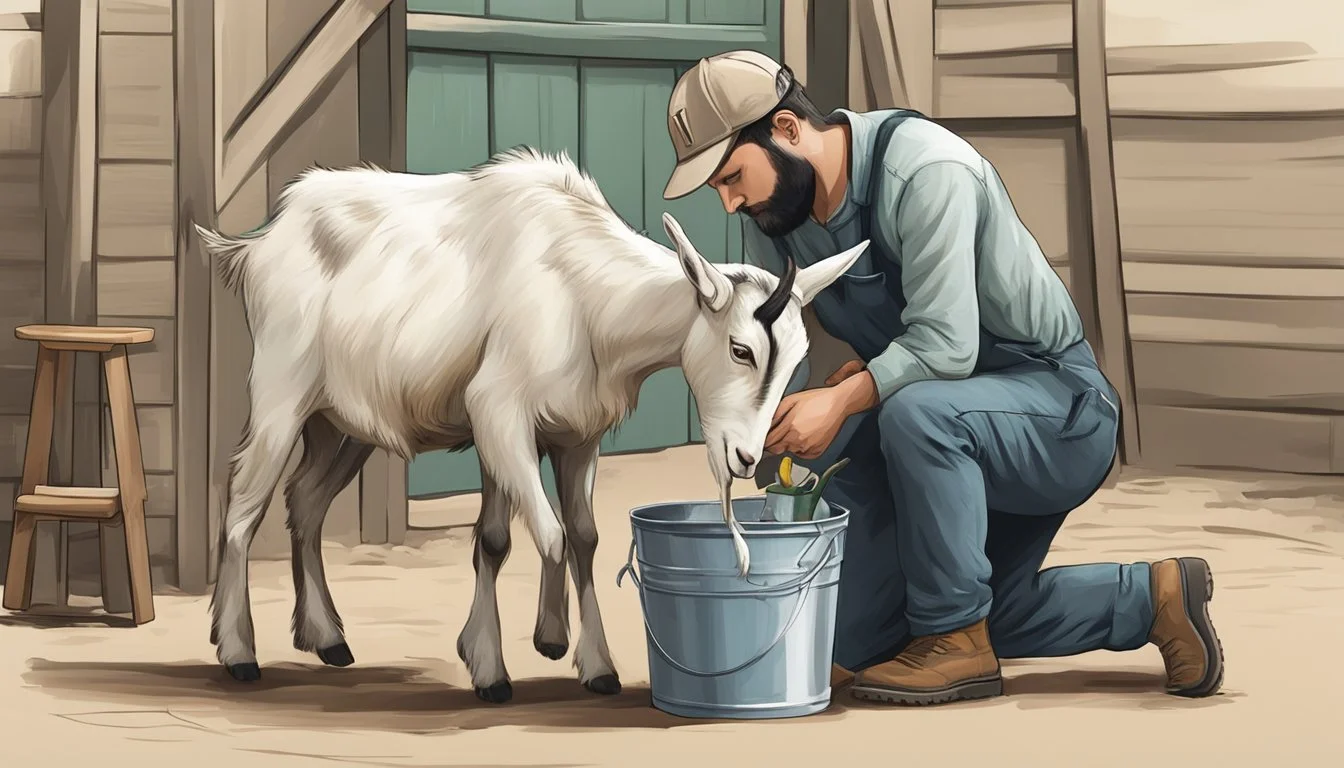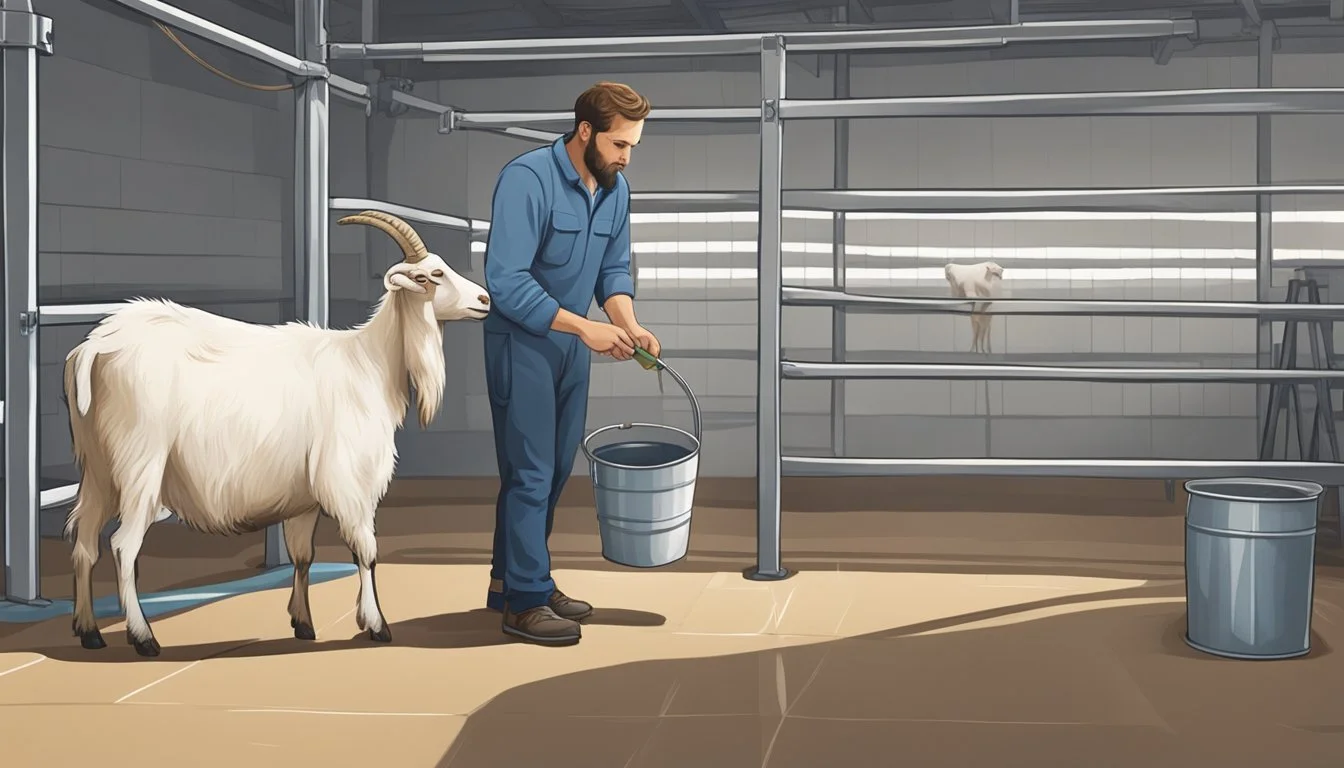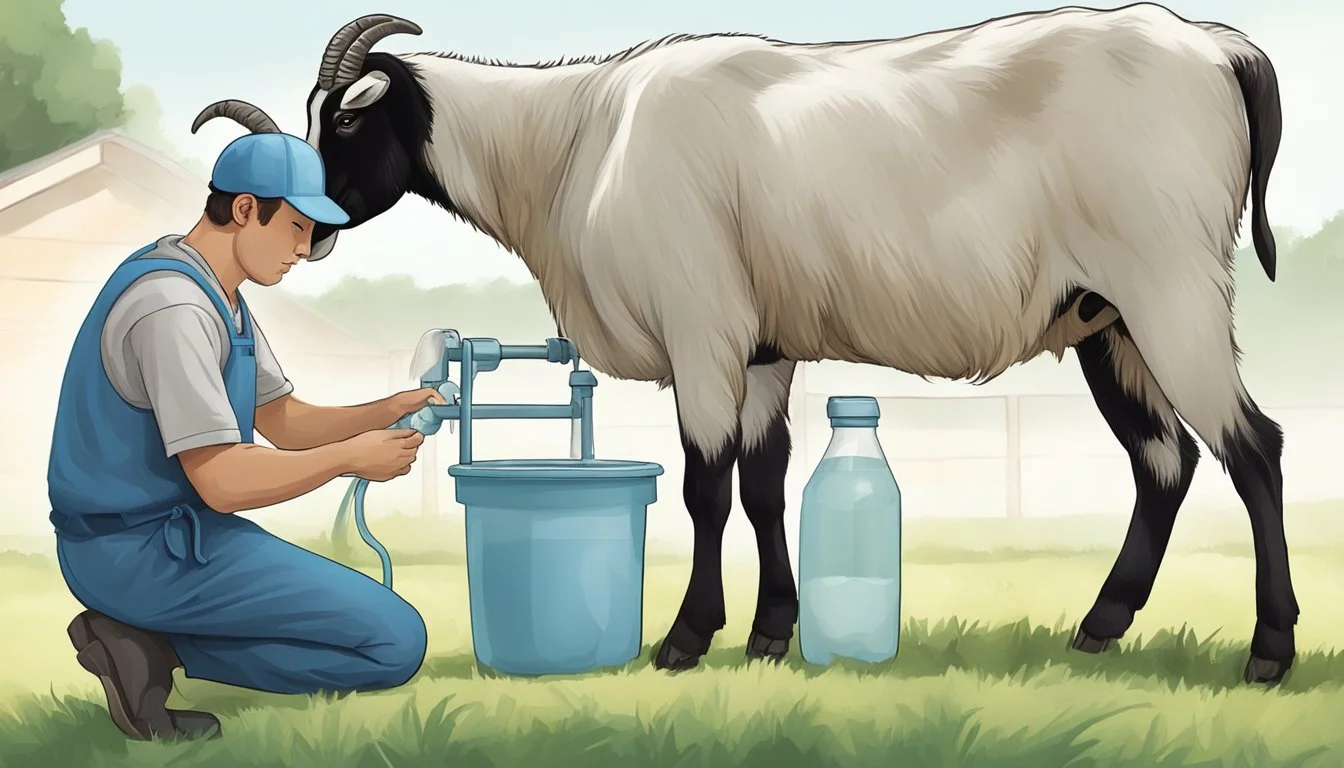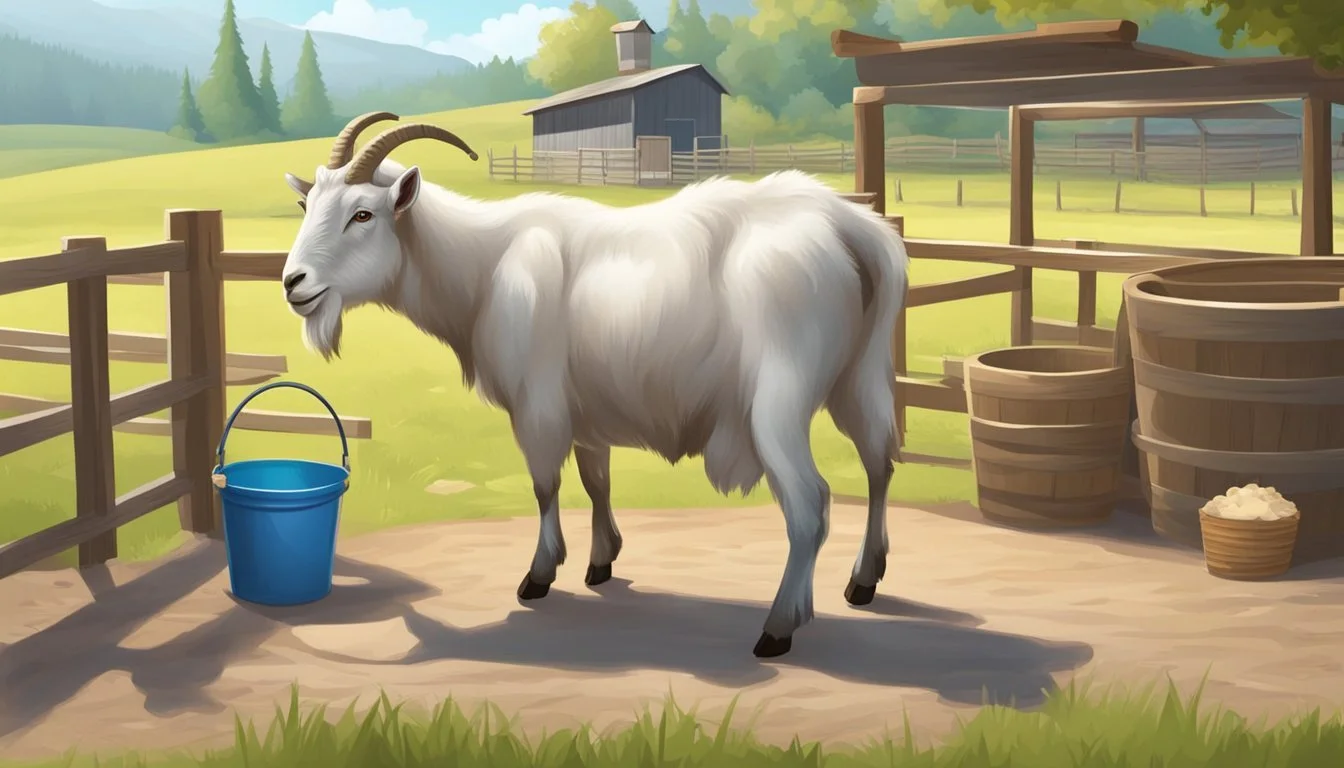How do I Milk a Goat?
Essential Tips for Beginners
Milking a goat is a straightforward process that can be learned fairly quickly with the right guidance and practice. Goats have been milked for thousands of years, and the milk is known for its nutritional value and distinct taste, making it a staple in many diets around the world. While the task may seem daunting at first to a novice, with a basic understanding of the goat’s anatomy and milk production, anyone can master the art of goat milking.
Before one begins milking a goat, it is important to ensure that the goat is comfortable and secure. A clean and calm environment contributes to the efficiency of the milking process and the quality of milk obtained. The milker should have clean hands and equipment to prevent contamination, and the goat’s udder and teats should be properly prepped, highlighting the importance of hygiene and animal welfare.
The milking technique itself involves a gentle but firm hand to extract the milk without causing discomfort to the animal. It requires rhythm and coordination to apply the right pressure on the udder and teats and effectively collect the milk. Regular milking not only benefits the dairy production but also the health of the goat, through the prevention of engorgement and potential mastitis. This delicate balance of care and skill ensures a successful outcome for both the goat and the milker.
Understanding Goat Anatomy
When milking a goat, it's essential to have a firm grasp of their anatomy, specifically the structures involved in lactation and the variables, such as breed, that influence milk production.
Udder and Teats
The udder of a dairy goat is made up of two symmetrical halves, each with its own mammary gland. This gland is where milk is produced and stored before being expressed. Each half of the udder has a single teat, through which milk is released during milking. The anatomy of the udder is supported by strong connective tissues and ligaments to maintain its position. Proper udder and teat health is vital for efficient milk production and to prevent the occurrence of infections such as mastitis.
Breeds and Characteristics
Dairy goats come in various breeds, each with unique characteristics affecting their milk yield and ease of milking. Notable breeds include Alpine, Nigerian Dwarf, Nubian, Saanen, Toggenburg, Oberhasli, and Sable. For example, Nigerian Dwarf goats are praised for their high butterfat content, while Saanen goats are appreciated for their volume of milk production.
Health and Lactation
Lactating does require exceptional care to maintain robust goat health throughout their milk-producing period. Health issues affecting lactating does can have adverse effects on milk supply. These problems can range from nutritional deficiencies to illnesses like mastitis, an inflammation of the mammary gland often caused by an infection. Additionally, the quality of care during pregnancy influences the quality and quantity of colostrum, the nutrient-rich first milk vital for newborn goats. Monitoring goat health and addressing issues promptly is crucial for sustaining lactation and ensuring the wellbeing of the dairy goat herd.
Preparation for Milking
Prior to milking a goat, it is essential to set up a clean and organized environment, provide proper nutrition, and sterilize the milking equipment. Each step is crucial in obtaining high-quality milk and ensuring the well-being of the animal.
Milking Stand and Environment
The milking stand should offer a stable and comfortable space for the goat. Ensure that the stand is in a sheltered area to protect from the elements, and the vicinity is free from hazards. A secure fence is also necessary to prevent any unwanted entry from bucks or predators. Additionally, the area should be equipped with a source of fresh water for the goat to stay hydrated.
Shelter: Must have ample space, be well-ventilated, and clean.
Milking Stand: Should be sturdy and at a comfortable height.
Fence: Secure enough to prevent escape or interference.
Feeding and Nutrition
Offering the right food before milking can help the goat feel at ease. Prepare a mix of grain and hay or alfalfa to entice the goat onto the milking stand. Providing fresh water and high-quality grass or alfalfa hay contributes to the goat's overall health and, consequently, the quality of milk produced.
Feed: Grain and hay/alfalfa mix.
Nutrition: High-quality, clean feed is essential for quality milk.
Milking Equipment
Before beginning, gather all necessary milking equipment and ensure it is thoroughly cleansed. The equipment includes a bucket or milk pail, strip cup, milk filters, and clean utensils. Use disposable gloves for hygiene, and iodine to sterilize the teats. Having several glass jars prepared allows for immediate storage of milk.
Bucket/Milk Pail: Stainless steel preferred for easy sterilization.
Strip Cup: A small cup for checking milk quality before full milking.
Iodine: For teat sanitation before and after milking.
Proper preparation streamlines the milking process and contributes significantly to the safety and comfort of the goat as well as the quality of the milk obtained.
Milking Process
The milking process is a critical routine that ensures the health of the goat and quality of the milk. Proper hygiene, technique, and aftercare are fundamental for successful milking.
Pre-Milking Procedures
Before milking a goat, thorough sanitation and preparation are essential. Wash hands and sanitize equipment to prevent contamination. First, prepare the goat by securing it in a comfortable position and calmly massaging the udder to promote let down. Use a strip cup to check for signs of infection and ensure a healthy milk supply.
Effective Milking Techniques
Once the goat and equipment are ready, employ the correct milking technique. Form a “C” shape with your thumb and fingers, secure the base of the teat, and firmly squeeze to trap milk in the teat. Work rhythmically, alternating hands to maintain a consistent flow, being careful not to tug or pull harshly which could cause discomfort or damage to the goat.
Post-Milking Practices
After milking, immediately practice good milk storage techniques, such as cooling the milk to preserve its freshness. Clean the goat's udder once more with a teat dip in an iodine solution to prevent infection. Finally, ensure all equipment is thoroughly cleaned and the area is tidied to maintain a sanitary environment for the next milking, typically done once or twice a day.
Handling Milk and Milk Products
After milking a goat, it is essential to handle goat milk properly to ensure safety and quality. This involves meticulous storage, prompt filtering to remove impurities, and understanding the distinct characteristics between goat milk and cow milk, especially when cheese making.
Storing and Filtering
Proper storage of goat milk begins immediately after milking. Milk should be cooled to under 40 degrees Fahrenheit within an hour to slow the growth of bacteria. For this purpose, refrigeration is crucial. To ensure purity, milk is passed through a milk filter to catch any debris before it is stored. Glass jars are preferred for storage as they can be sterilized easily and don't impart flavors to the milk.
From Milk to Cheese
Goat milk's high nutrient content makes it ideal for cheese production. The process begins with pasteurization, followed by the addition of cultures and rennet which coagulate the milk. The solid curds are then separated, pressed, and aged to produce a variety of cheeses. Each cheese type requires specific handling and aging to develop the desired flavor and texture.
Goat Milk vs. Cow Milk
When comparing goat milk to cow milk, it is noted that goat milk is naturally homogenized and easier to digest due to smaller fat globules and the presence of A2 beta-casein. Moreover, the milk from goats tends to have higher levels of certain nutrients like calcium, potassium, and vitamin A, though cow milk is typically higher in vitamin B12 and folic acid. Each milk type brings its unique properties to cheese-making, affecting taste, texture, and nutritional content.
Goat Management and Care
Managing goats efficiently requires an understanding of their dietary needs, living requirements, and health monitoring. Ensuring the well-being of goats involves comprehensive care and regular veterinary check-ups to detect and prevent diseases.
Reproductive Health
Reproductive health is critical in raising goats, especially for milk production. A doe's estrus cycle occurs roughly every 21 days and understanding the signs of heat is vital for successful breeding. During the breeding season, a buck will often be introduced to induce pregnancy. Monitoring and managing the gestation period, which averages 150 days, is necessary for the health of both the doe and the ensuing kids. After the birth, the process of freshening, where the doe begins milk production, takes place. It is significant to follow proper procedures during weaning kids and consider bottle raising if required.
Daily Routine and Shelter
Goats require a consistent daily routine and a secure shelter to thrive. Their enclosure should have a sturdy fence to prevent escape and protect from predators. Within the shelter, providing a dry and clean environment is critical to prevent diseases. Food and fresh water should be available at all times, with a diet rich in nutrients to meet their needs, particularly for lactating does. Incorporate a stanchion in the milking area to safely and efficiently milk the goats.
Health Monitoring
Regular health monitoring is imperative to identify and treat illnesses quickly. Common ailments in goats include mastitis, an infection of the udder, which can be prompted by unsanitary milking practices. Veterinary care should be sought for any signs of illness immediately. Besides inspecting for signs of diseases, it is important to maintain up-to-date vaccinations and deworming schedules to preemptively safeguard goat health.
Advanced Milking Techniques and Tips
Advanced techniques in goat milking can significantly enhance productivity and ensure the health of the goats. Employing cutting-edge milking machines and optimizing milking procedures not only reduces labor but can also improve milk yield and quality.
Machine Milking Advances
Modern milking machines have revolutionized the milking process by providing consistent and efficient milking. The latest advancements include:
Automated Milking Systems (AMS): These systems allow goats to be milked on-demand, reducing the stress on the animals and labor for the farmer. They are equipped with sensors that identify each goat, guide them to the milking station, and customize the milking session accordingly.
Pulsation Speed and Vacuum Levels: Contemporary machines come with adjustable pulsation speeds and vacuum levels that mimic the natural milking action, which is gentler on the goat's teats and helps prevent injuries or infections.
Improving Milking Efficiency
Improving milking efficiency goes beyond the machine itself; it involves a comprehensive approach to the entire milking process:
Optimal Milking Supplies and Preparation: The cleanliness of teats and udders, along with sanitary milking supplies, is vital. Pre-milking teat dips and sanitizing udders can lead to better milk quality and healthier goats.
Training and Technique: Adequate staff training to handle advanced machines ensures the milking technique is applied correctly, which can lead to a more efficient process and a reduction in the labor required.
Routine Maintenance: To maximize efficiency, regular maintenance of milking equipment is necessary. This includes checking tubes, liners, and gaskets for signs of wear and ensuring all parts are clean and functioning properly.
By implementing these advanced techniques and tips, goat milkers can achieve their goal of efficient and effective milking while caring for the health of their goats.
Potential Challenges and Solutions
Milking goats can be a rewarding practice, but it presents its own set of challenges, ranging from health issues to behavioral problems. Understanding these challenges and their solutions ensures efficient milk production and maintains the welfare of the goats.
Dealing with Common Diseases
Goat health is crucial for successful milk production. Mastitis, an inflammation of the mammary gland, is a common disease that can affect milk quality and yield. To prevent mastitis, one must maintain hygienic milking practices and promptly treat any infections. Regular health checks can identify symptoms early, and a clean environment reduces disease spread.
Managing Difficult Goats
Some female goats may exhibit difficult behavior during milking due to discomfort or temperament issues. Solutions include gentle handling, consistent milking routines, and providing a calm environment. If a goat continues to be uncooperative, they may require additional training or alterations to the milking stand to enhance comfort.
Milking Quantity and Quality Issues
Milk production can be influenced by various factors, including the goat’s nutrition and overall health. Ensure goats receive a balanced diet optimized for lactation—this may increase milk yield and improve quality. For concerns about production loss or inadequate milk quality, one should assess for health issues like parasitic infections and implement a quality control regimen to monitor and address potential problems.
Through a combination of preventative health care, proper milking management, and rigorous attention to the goat's diet and living conditions, one can overcome common milking challenges and foster a productive and healthful environment for milking goats.
Ethical Considerations and Practices
In goat milking practices, ethical considerations hinge on ensuring the wellbeing of the animals involved. Maintaining a high standard of animal welfare is paramount.
Animal Welfare
Goat owners bear responsibility for the ethical treatment of their animals during milking procedures. Animal welfare encompasses a range of ethical concerns, including the humane handling of goats, the avoidance of unnecessary stress or pain, and the provision of proper living conditions.
Separation of Kids: In maximizing milk production, kids are often separated from does at an early age, a practice that raises ethical questions regarding the emotional health of both doe and kid.
Culling of the Herd: Unproductive goats, including old does and young males or 'bucklings', may be culled. Responsible goat owners carefully consider the need to castrate male kids for herd management while respecting the animals' well-being.
Living Conditions: Ethically managed dairies provide clean, spacious, and enriched environments that promote the health and comfort of dairy goats.
Health Management: Ethical care requires routine health checks and immediate attention to any ailments, ensuring the goats are healthy and in good condition.
By incorporating these ethical practices, owners can ensure that their goat husbandry not only efficiently produces milk but also preserves the integrity and welfare of their dairy goats.
Personal Experiences and Case Studies
In the world of goat milking, personal journeys and shared experiences form the bedrock of knowledge. Here, individuals' stories of raising goats bring to light the triumphs, the hurdles, and the wisdom gained through their unique adventures in milk production.
Success Stories
Sheila's Steady Climb: Sheila began her journey with two Alpine goats and a simple milking stool. She meticulously recorded her daily output, watching as her gentle technique led to a steady increase in milk production. Two years later, Sheila boasts a thriving dairy with an admirable volume of high-quality goat milk.
Community Champion: A small farmer's market became a communal hub after Mike introduced his homemade goat cheese. A testament to the quality of his milk, this cheese has not only garnered local acclaim but has also inspired others in the community to start raising goats.
Lessons Learned
The Lost Batch: Jeremy, overwhelmed by the enthusiasm of his new adventure, neglected the essential step of proper storage, leading to a spoiled batch of milk. This hard lesson underlined the importance of immediate chilling after milking, a practice he has since perfected.
Jessica's Technique Tweak: Initially, Jessica found milking to be arduous. With time, she adapted her hand movements, discovering that starting at the base of the teat and working upward was key. Through persistence, she transformed milking from a chore into a comfortable routine.
Community Insights
Raising Goats 101: Long-time goat farmers emphasize the importance of a clean and stress-free environment for the goats. They collectively note that content goats produce more milk, a detail all too important for production optimization.
Husbandry Workshops: The community often hosts workshops where experienced farmers like Rachel share insights into the nuances of milking. They assert that attention to the goat's health and proper milking techniques are pivotal to ensuring a bountiful supply of fresh, creamy milk.
Conclusion
Milking a goat effectively is a skill that improves with practice. The key steps to successful goat milking include preparation, cleanliness, technique, and post-milking care. Handlers must prioritize the goat's comfort and health, as it directly influences milk production and quality.
Preparation: Ensuring the goat is calm and feeding can make the milking process easier for both the animal and the milker.
Cleanliness: Thorough cleaning of the udder and hands is essential to prevent contamination.
Milking Technique: A consistent and gentle technique should be used when milking, alternating between teats to ensure complete emptying of the udder.
Post-Milking Care: After milking, applying a teat disinfectant helps in preventing infections.
Milk storage is just as crucial; the milk must be cooled quickly to maintain its freshness. Consulting reliable guides such as MorningChores or The Happy Chicken Coop for step-by-step instructions and tips can be beneficial for new and experienced goat keepers alike.
In essence, proper milking practices ensure the well-being of the goats and yield high-quality goat's milk. Individuals who diligently follow these practices are likely to find the process gratifying and the results rewarding.
Additional Resources
In the quest to master the art of goat milking, enthusiasts and farmers alike can benefit greatly from a wealth of dedicated resources. These materials span across various mediums, offering comprehensive knowledge and practical advice for both beginners and seasoned goat keepers.
Further Reading and Research
For those looking to expand their understanding, books such as The Small-Scale Dairy by Gianaclis Caldwell provide in-depth insights into dairy processing and animal care. Another valuable read is Storey's Guide to Raising Dairy Goats by Jerry Belanger and Sara Thomson Bredesen, offering thorough advice on care, breeding, and milking.
Leveraging online resources is another effective method for learning. Websites such as The Happy Chicken Coop detail the intricacies of goat milking and husbandry. Similarly, instructional guides from sources like MorningChores break down the milking process into easy-to-follow steps.
When seeking out articles, industry journals and agricultural websites are a treasure trove of practical tips. Articles typically cover a range of topics, from improving milk production to ensuring the health and well-being of dairy goats.
As learning never ceases, attending workshops or webinars can be incredibly beneficial. They provide opportunities to ask experienced goat keepers questions and often offer hands-on experience that is invaluable for honing one's technique.
Lastly, online forums and communities are an immense resource for peer support. They allow for the sharing of experiences and solutions to common challenges in goat milking, fostering a collective pool of wisdom.







